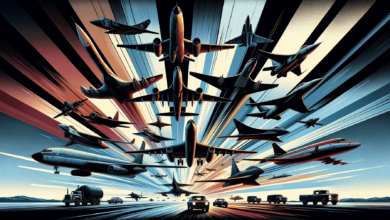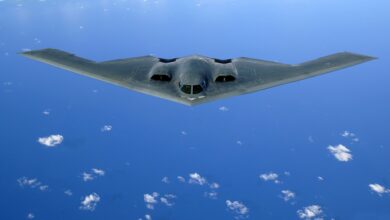Echo of Rotors: The Bell UH-1 Huey

Introduction
There exists in the annals of aviation a machine that transcends the boundaries of time and technology, imprinting itself in the collective consciousness of multiple generations. The Bell UH-1 Iroquois, universally known as the Huey, is more than just a helicopter; it is an icon of resilience, versatility, and innovation. Born out of necessity, thriving in adversity, and aging like fine wine, the Huey’s tale is one of extraordinary feats and undying legacy.
Origins: The Advent of a Revolution
The Huey’s journey began in the 1950s, against the backdrop of the Cold War. The United States military, recognizing the need for an efficient medevac and utility helicopter, set the stage for the birth of an aviation legend. Bell Helicopter, seizing the opportunity, presented the design that would evolve into the Huey. With its first flight in 1956, the Bell 204 prototype paved the way for a new era in helicopter aviation.
The Huey’s early design was a blend of simplicity and functionality. The initial models, equipped with piston engines, soon gave way to the more powerful Lycoming T53 turboshaft engine, distinguishing it from its contemporaries. This leap in powerplant technology bestowed upon the Huey a combination of range, speed, and lifting capabilities that were unheard of in previous rotorcraft.
The Huey in Vietnam: A Symbol of War and Hope
It was in the jungles of Vietnam that the Huey etched its name in history. The Vietnam War saw the Huey transform from a utility vehicle into a symbol of American military might and humanitarian aid. Its roles were as diverse as the war was complex – troop transport, gunship, medevac, and supply carrier, each task performed with an efficiency that became the stuff of legend.
The Huey’s presence in Vietnam was not just about numbers; it was about impact. The sight of a Huey descending into a hot LZ (landing zone) became synonymous with both the horrors and hopes of war. Its ability to evacuate the wounded, often under heavy fire, saved countless lives, making it a beacon of hope in the midst of chaos.
Continuing in the next section, we’ll delve into the technical innovations of the Huey, its impact on helicopter design, its role beyond the Vietnam War, and its enduring legacy in both military and civilian aviation.
The Evolution of the Huey: Models and Variants
Over its service life, the Huey evolved through numerous variants, each tailored to specific needs. From the early UH-1A to the UH-1Y Venom, these variants showcased improvements in payload, range, and technology. The UH-1B introduced a larger engine and rotor blade, the UH-1C was tailored for gunship roles, and the UH-1D/H models became the workhorses, widely recognized in Vietnam.
Each variant of the Huey tells a story of adaptation – the UH-1M’s modified gunship role, the HH-1K’s search and rescue configuration, and the UH-1Y’s modern avionics and composite materials. This evolutionary lineage not only highlights the versatility of the Huey but also underscores the continuous quest for improvement in aviation technology.
The Huey’s Engineering: A Closer Look
The Huey’s engineering marvels are worth a closer examination. Its airframe, designed for durability and ease of maintenance, could withstand significant stress and damage. The rotor system, a hallmark of the Huey, was ingeniously simple yet highly effective, contributing to the helicopter’s agility and responsiveness.
The engine, initially the Lycoming T53, and later more powerful versions, was the heart of the Huey. It offered a perfect balance of power and efficiency, enabling the helicopter to perform a variety of demanding tasks. The transmission system, another critical component, was robust and reliable, a necessity for the diverse operational environments of the Huey.
The Huey in Action: Tales of Valor and Service
Throughout its service, the Huey has been part of countless operations and missions, each adding to its legacy. Stories of its use in Vietnam are legendary – swift troop insertions, daring medevac missions under fire, and intense air support operations. In civilian roles, the Huey’s contributions to disaster relief, emergency medical services, and firefighting are equally commendable.
Personal accounts from pilots, crew members, and soldiers who interacted with the Huey paint a picture of a machine that was more than just a tool of war or work – it was a lifeline, a guardian, and a symbol of hope. These stories, passed down through generations, keep the spirit of the Huey alive.
The Huey in Popular Culture: From War to Screen
The impact of the Huey extends into popular culture. Its distinctive shape and sound have made it an icon in cinema, television, and music. Films like “Apocalypse Now” and “Platoon” have immortalized the Huey, capturing its essence in the context of war. In music, songs like “Fortunate Son” by Creedence Clearwater Revival and “Gimme Shelter” by The Rolling Stones evoke images of the Huey and its era.
Television documentaries and series have also featured the Huey, educating new generations about its roles and significance. Model kits, video games, and literature have further cemented its place in the public imagination, making the Huey a symbol of a tumultuous era and a testament to human ingenuity.
Preserving the Legacy: The Huey Today
Today, the Huey is revered as a piece of living history. Preserved in museums, displayed in memorials, and flown in vintage aircraft shows, it continues to draw crowds, a testament to its enduring appeal. Enthusiasts and veterans alike work to restore and maintain these aircraft, ensuring that the legacy of the Huey is not forgotten.
As technology advances, and newer helicopters take to the skies, the Huey’s influence remains evident. It has set standards in helicopter design, military tactics, and multi-role capabilities that continue to guide the development of future rotorcraft.
Conclusion
The Bell UH-1 Huey’s saga is a tapestry woven with threads of innovation, bravery, and adaptability. It has played a pivotal role in shaping helicopter aviation and has left an indelible mark on the course of history. The Huey is not just a helicopter; it is a symbol of an era, a beacon of progress, and a testament to the enduring spirit of exploration and resilience. As it continues to fly in various corners of the world, the Huey’s legacy soars ever higher, reminding us of the profound impact one aircraft can have on the world.
Featured: Bell UH-1H Huey Diecast Model

Own a Piece of Aviation History: Premium 1/48 Scale Bell UH-1H Huey (Iroquois) Diecast Model
As you’ve journeyed through the remarkable story of the Bell UH-1 Huey in our latest article, how about bringing a piece of this history into your home? Introducing the exclusive 1/48 scale premium diecast model of the US Army Bell UH-1H Huey (Iroquois), a must-have for aviation enthusiasts and collectors alike.
This meticulously crafted model, with a fuselage length of 26.5cm (10.4″) and a rotor span of 30cm (11.8″), is more than just a replica; it’s a tribute to the Huey’s enduring legacy. Its main and rear rotors spin freely, adding a touch of realism to its display. The transparent windows and genuine markings meticulously replicate the iconic helicopter, capturing its essence down to the finest detail.
Each model comes with a free metal display stand, providing a perfect showcase for this exquisite piece. Whether you’re an avid collector, a history buff, or someone who appreciates the beauty of aviation, this premium diecast model is an excellent addition to your collection.
Embrace the opportunity to own a slice of aviation history. Add the Bell UH-1H Huey model to your collection today and let the legend of the Huey continue to inspire you every day!
>> Get your own UH-1H Huey Diecast Model – Click here to view more details or to purchase! <<




